Have you made the commitment to eat healthier?
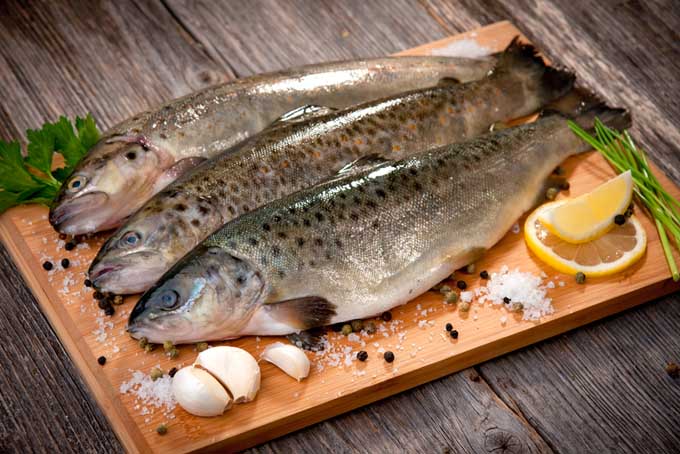
Perhaps you’d like to lose a bit of weight. Or maybe you’ve been advised that you’re at risk for coronary heart disease, or have already been diagnosed with CHD.
If you’re considering adding more fish to your diet because of their high concentration of healthy nutrients, please read on.
In this article we’re going to cover some of the health benefits of eating fish, seafood, and aquatic invertebrates, how to select the best choices for optimal well-being, and a couple of recipes to prepare delicious fish-based dishes that are quick and easy to make – so let’s get to it.
Fish and Omega-3 Fatty Acids
Omega-3 fatty acids, sometimes referred to as O3FA’s or n-3 fatty acids, are polyunsaturated fatty acids that are among the essential nutrients required for health, vitality and energy. And as our bodies don’t produce these fats, we need to get them from food sources.
There are two primary groups necessary for our requirements. One type is alpha-linoleic acid, (AHA), and comes from green veggies in the brassica family such as broccoli, Brussels sprouts, cabbage and kale as well as salad greens. AHA is also found in quantity in vegetable oils – canola, soybean, flaxseed and walnuts.
The second type, eicosapentaenoic acid (EPA) and docosahexaenoic acid (DHA), is found primarily in the meat of fatty fish, which are listed below.
Some Benefits from Eating More Fish
O3FA’s are noted for their many health benefits such as:
- The control of blood clotting.
- Building cell membranes in our brains.
- Protection against heart disease – decreasing risk of arrhythmias and reducing both high triglyceride levels and plaque in the arteries.
- A slight reduction in high blood pressure.1
Recent studies are also encouraging in their findings; indications are for beneficial properties in the prevention and regulation of numerous other areas of concern.
Of particular interest is their effect on chronic inflammation, which is associated with accelerated aging and the following diseases: rheumatoid arthritis, asthma and COPD, neurodegenerative conditions that affect cognition and metabolic syndrome.2
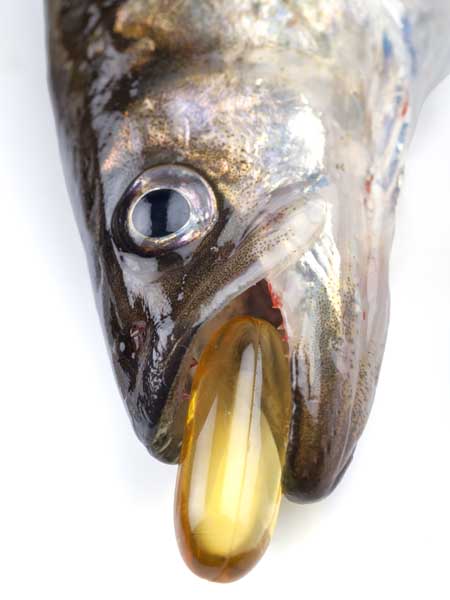
And Some Concerns
If you’ve heard about the benefits of adding more seafood to your meal plans, you’ve probably also heard about some concerns. Let’s have a look to see how they balance out.
The main toxins found in fish are:
- Mercury (a heavy metal).
- Dioxins (a by-product of pesticide production and paper manufacturing), and
- Polychlorinated biphenyls or PCB’s (man-made chemicals once used in the insulation of electrical transformers, lubricants, plastics, adhesives, flame-retardant paint, etc).3
According to this recent article on heart disease posted on the Mayo Clinic’s website, the health benefits of eating fish far outweigh concerns about toxins and mercury levels. This is especially relevant as we hit middle age and beyond – as long we’re selective in the species we eat.
Moreover, the American Heart Association recommends eating a variety of marine life for people with and without heart disease, but again avoiding certain types. Even pregnant women and young children can enjoy heart-smart benefits by limiting their intake and choosing wisely.
The AHA recommends4 the following guidelines for consumption:
– At least two servings per week, each serving being 3.5 ounces of cooked fish.
– Expectant mothers, women who are breast feeding and children should restrict intake to a total of 12 ounces per week of cooked fish, and no more than 6 ounces of canned tuna; with no selections being made from the species with high toxin levels.
Good Fish, Bad Fish
How can you tell which varieties to avoid? The bigger fish in the food chain have larger amounts of mercury – they eat small ones and so accumulate more in their systems. And, they live longer so have more time to collect toxins. Avoid larger species such as shark, swordfish, tilefish, marlin and king mackerel.
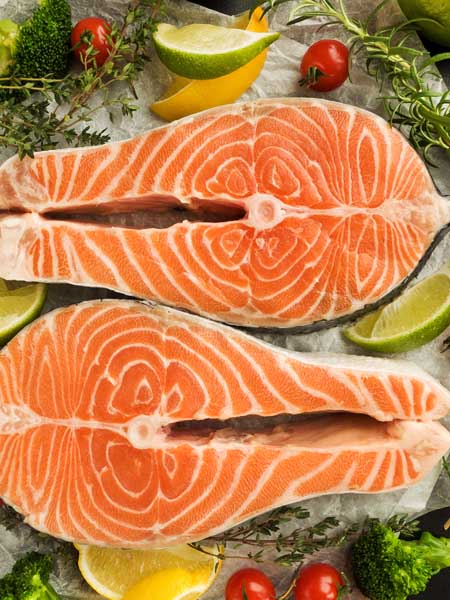
Which are best? Choose from a list of fatty fish such as wild salmon, common mackerel, herring, lake trout, sardines and albacore tuna for high levels of O3FA’s. And here’s some choices that are low in mercury and pollutants – shrimp (fajitas, anyone?), wild salmon, pollock, catfish, cod, flounder, sole and canned light tuna.
For more information, this table on the American Heart Association’s web site compares levels of n-3 fatty acids and mercury contamination in fish. And this page of the Food and Drug Administration’s website has an extensive list of fish and comparative mercury levels.
Buying, Preparation and Cooking
I happen to live in the Pacific Northwest so I’m set and have fresh seafood available all the time and pretty much all-year around. However, not everyone is so lucky.
Whether you buy from a market specializing in seafood or from your local grocer, always ensure your selection is fresh and firm. It’s fish, and will smell like it, but it shouldn’t smell over-the-top ‘fishy’ – if it does, give it a pass as it’s been on the shelf too long.
When purchasing, remember that certain varieties will ‘shrink’ in the cooking process, so choose the weight that will correspond to the cooked product.
Before cooking, rinse your selection in cold running water and pat dry with paper towels. Remove any bones from filets with a pair of small, bent-tip needle nose pliers; these give a much better grip than tweezers.
You can pick up a good pair for a reasonable price at any crafters’ store, and wash with warm soapy water before using. Also, you’ll have to stash them somewhere safe in your kitchen so the mechanically minded in your household don’t swipe them for other uses.
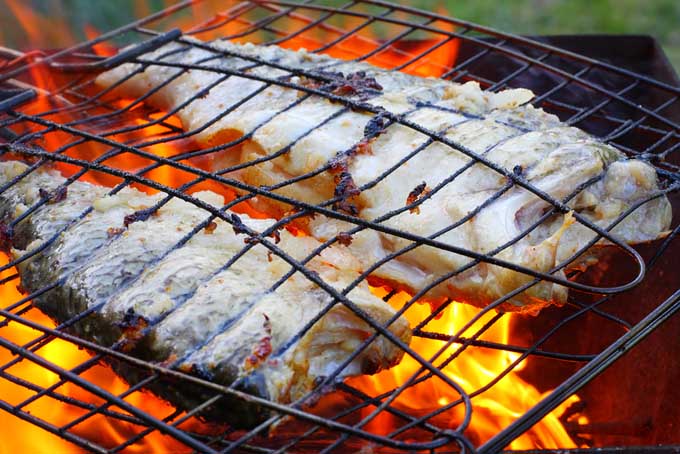
The best methods for cooking are baking and grilling; the newest method of grilling that involves using cedar or hardwood planks and adds a nice new flavor. Planks also avoids charring the food which may cause carcinogens to form in the burnt areas.
Avoid frying and deep-frying as they counteract the heart-smart benefits of seafood and its fresh water counterparts. Sadly, enjoying a meal of fish and chips at the beach should be restricted to very occasional indulgences, though you can make our lighter, gluten-free salt and vinegar baked fish whenever that craving strikes!
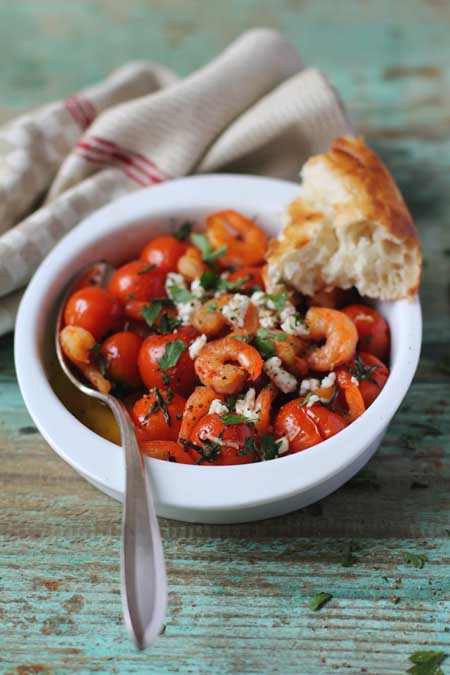
Salmon and invertebrates such as oysters, prawns and scallops are all well suited for the barbeque. It’s also not too difficult to transform delicious, healthy salmon into a mouth watering burger, and we’ve got the recipe to prove it!
Cod and clams make wonderful, hearty chowders for winter – add mussels, prawns and scallops for a tasty bouillabaisse, another winter treat. It’s easy to prepare in larger pots made for cooking crabs, clams, and lobster.
Sole, flounder, red snapper, pollock, trout, salmon and cod all do well in the oven with a simple sauce of herbs, pepper and lemon juice. Serve with a salad, lightly steamed vegetables and brown rice or quinoa, for a grain-free option. You can also use the simply cooked fish as the main component of a sushi bowl.
For a quick dinner, make our recipe for fish with brown butter sauce, using sole.
To add flavor to your dish, season with spices, herbs, the juice and zest of lemons and limes, low-sodium broths and low-fat sauces. Opt to create your own sauces and condiments over store bought products, as commercial products are often made with high levels of sugar, preservatives and saturated fats. These ‘hidden’ ingredients contribute to metabolic syndrome; the accumulation of excess belly fat, which is major factor in contributing to heart disease.
Choosing to add a variety of sea food to your eating plan on a regular basis is cost effective, simple, delicious and heart-smart. It’s one more step in looking after your health, and that’s a choice we all need to be making.
Try out the following recipes – they’re quick and easy preparation makes these healthful, savory dishes taste even more scrumptious.
- 1 lb red snapper or pollock 4 filets
- 1 lemon thinly sliced, preferably organic
- 1 lemon zest and juice, preferably organic
- 2 cloves garlic finely minced
- 1 Tbsp parsley finely chopped
- 1 Tbsp tarragon or basil finely chopped
- 1 tsp black pepper freshly ground
- 1 Tbsp olive oil
- 1/4 cup white wine or apple juice
- Pre-heat oven to 350 degrees. Remove any remaining bones from the filets. Spray a shallow casserole dish with non-aerosol cooking spray and arrange the filets flat, so they’re not touching. Add the sliced lemon to the top.
- In a jar, add all remaining ingredients, screw on the lid tightly and shake vigorously until mixed. Pour mixture over the fish and place, uncovered, in the oven.
- Bake at 350 degrees for 25 – 30 minutes, just until the sauce is reduced by half. Bake first for 15 minutes then remove from oven and baste with the sauce. Bake for another 7 - 8 minutes and baste again, scraping the browning on the edge of the dish to mix with the sauce. Bake for another 5 – 8 minutes, once again scraping the edges to mix with the sauce.
- The sauce reduces slowly in the first 15 minutes, then quickly in the last half of baking time, so you’ll want to keep an eye on it by setting a timer. Have all the other meal ingredients ready and serve piping hot directly onto the table.
This is a light and nourishing dish that goes well with a tossed garden salad, steamed veggies or baked yam fries and a flavorful baguette. Serve the dish right on the table as you’ll want to sop up the tasty reduction with bread or use it as a dip for the yam fries.
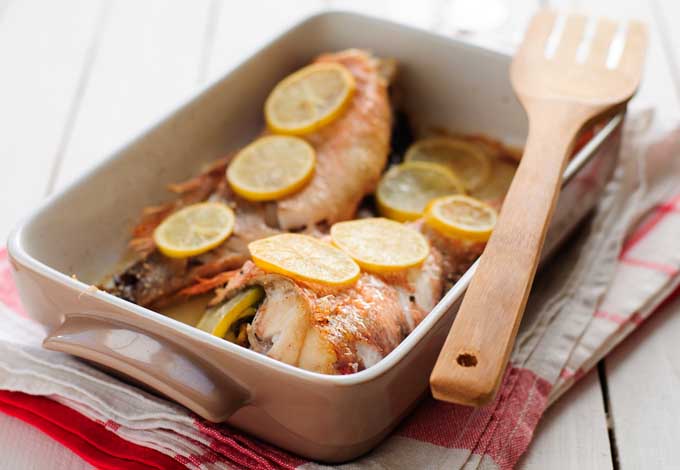
- 1 lb large prawns peeled and deveined and tails removed
- 1 large sweet onion cut into bite sized chunks
- 1 large red pepper cut into bite size chunks
- 1 large orange pepper cut into bite size chunks
- 1 large green pepper cut into bite size chunks
- 2 cloves garlic finely minced
- 20 – 25 cherry or plum tomatoes* or 1 can of whole stewed tomatoes
- 1 tbsp fresh oregano coarsely chopped
- 16 – 20 pitted Kalamata olives
- 4 oz crumbled Feta cheese preferably goat’s milk
- 1 tsp coconut oil
- Heat a large Dutch oven over medium high heat, add the coconut oil and sauté the onions until just transparent. Add the peppers and continue sautéing for another couple of minutes. And the garlic and sauté for one more minute.
- Add the tomatoes (breaking them into quarters with a wooden spoon if using canned - leave whole if using fresh cherry tomatoes), oregano, and olives. Mix all ingredients together, reduce heat, cover and simmer for 10 minutes to blend the flavors.
- Add the prawns and cook just until pink all the way through.
- Stir in the Feta and cook for another minute or two, just until the cheese is heated, then serve in bowls.
References
1Dr. Frank Sacks, Harvard.edu. Retrieved from http://www.hsph.harvard.edu/nutritionsource/omega-3/
2Logan Bronwell, lifeextension.org Retrieved from http://www.lef.org/Magazine/2012/9/Fish-Oils-Health-Benefits/Page-01.
3Green Facts, greenfacts.org. Retrieved from http://www.greenfacts.org/en/pcbs/l-2/1-polychlorinated-biphenyls.htm
4American Heart Association, heart.org. Retrieved from http://www.heart.org/HEARTORG/General/Fish-and-Omega-3-Fatty-Acids_UCM_303248_Article.jsp
About Lorna Kring
Recently retired as a costume specialist in the TV and film industry, Lorna now enjoys blogging on contemporary lifestyle themes. A bit daft about the garden, she’s particularly obsessed with organic tomatoes and herbs, and delights in breaking bread with family and friends.

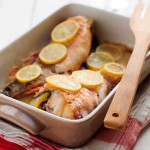

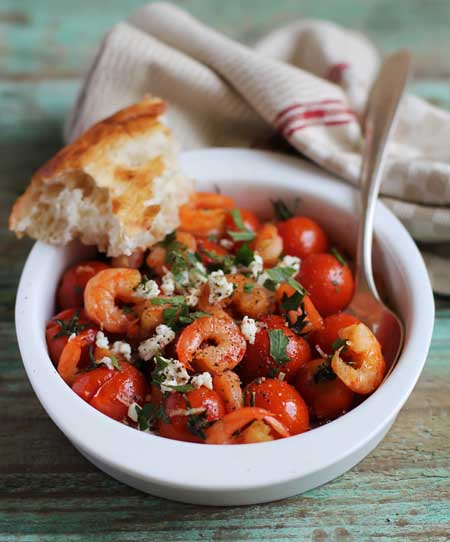



Oh man, good call. I didn’t know there were good fish types and bad fish types. I thought all fish was universally good for you.
I normally only eat tuna and salmon but recently I was thinking of broadening my spectrum since eating only two kinds can be a little boring even if you cook them in different ways. Good to know that I’ve avoided a potential booboo.
I think all fish are universally good – until our bad practices come into play. But, it is good info, particularly with young kids. Of course, you can never go wrong with salmon!
One REALLY YUMMY way to prepare fish that I’m surprised wasn’t mentioned here is to cook fish in parchment paper (aka en papillote). Basically, you put the fish and seasoning and all that good stuff into a neat little package made with parchment paper and you bake it until the fish is cooked. It’d work really well with all the fatty fish in this article due to all their juices that get released during cooking.
Just something to think about.
Great point queenbellevue, en papillote is a simply and delicious way to prepare fish. Do you have a favorite recipe?
I have always loved fish but I’ve found it particularly difficult to find very fresh fish. I also love fishing so that’s probably why I’ve become so jaded with what the grocers have to offer. I’d love to vacation solely to catch fish not available in my area.
You’re a fish ‘purist’ Joan – is there a fisherman’s wharf in your area Joan? That’s a good bet for the freshest catch of the day, unless of course, you catch it yourself!
I never eat fish, mainly because I don’t really know how to cook it. So thank you for these tips – I feel more confident about trying it now. I wasn’t aware about the mercury levels either – like TommyVercetti, I really thought all fish was healthy!
Glad to help you start on the fish path. I learned about the mercury problem a few years back when my elderly cat wouldn’t take her meds – her vet suggested mixing them in tuna, and gave me some info on mercury levels. It was surprising to me too.
Thank you for the tips, greatly appreciated! I love eating fish and my husband does also! Since we go out a lot we try to order fish in new restaurants, to see how it tastes!
I’ll try to cook some more now that I know how to prepare it better.
Thanks for your comments fuzyon, checking out how the experts do it is always great for inspiration!
I have had some fish in the freezer for an couple of weeks now. A friend caught them and cleaned them for us. I never cooked it because the one time I tried to cook fish before was a disaster! I have been waiting for a decent recipe to come along. I think I just found it. Thank you!!
Speaking of disasters where fish is concerned…count me in, plus i have a hate-hate relationship towards fish, i guess the trauma of eating one that was cooked up badly got me in that tangled web of ‘hate’… maybe with the recipes above, a will to follow through, a can-do-attitude, a change in/of heart…i might make the best fish plate ever and in the light of day stop all this venting!
When it comes to fish, when it’s done badly, it’s really bad! But, when it’s done well, ah, now that’s a different story. Just remember, “fresh, lightly seasoned and don’t overcook”… who knows, soon you may be dropping us a line about your love-love relationship with fish!
Let us know how your fish dish turned out km.
Excellent. I love fish. It is one of my favorite meals. I like nearly any kind, so it’s good to know more about it.
I have had concerns regarding toxins and such reports. It’s great to hear that the benefits outweigh the risks. Thank you, Lorna, for this information.
Fish on the grill sounds fantastic. I’ll have to see if my grill master husband can handle giving that a try.
Glad you enjoyed it Zyni, I’m a fish fanatic too. My favorite fish on the grill is a filet of salmon brushed with fresh chopped herbs, lime juice, pepper and a bit of olive oil – superb! Toss on some oysters in the shell to have as an appy while the salmon’s grilling, and I’m in heaven…
Yum! That sounds delicious. Some type of seafood appetizer works for me too, although I have to admit that oysters aren’t my all time favorite.
The salmon sounds wonderful though. Definitely something I’ll have to try. I’ve had fish over the campfire (in a skillet) but never right over the open flame.
I’d heard there were good and bad kinds, so I’m glad you did the research for me. I need to investigate the fish baskets for grilling, that looks like an easy way to have a healthy meal. I often eat the same types repeatedly, so now that I’ve got this list, I can explore new options.
Glad you enjoyed the post Diane, and grilling is a great way to try out new varieties. Another option for grilling is wrap the fish in parchment paper and wrap that in tin foil before putting on the grill.
I’m learning to like fish again. I went off it some time ago when I read all the stuff about mercury etc. But, as you say, I’m now satisfied that the benefits far outweigh any bad press fish has had in the past. I try to buy from a sustainable source wherever possible, and I stick to the main ones like salmon, cod, pollock and mackerel, and my favourite way to cook them is in a tin foil package I make myself, adding lemon and herbs, and popping in the oven.
Lately I’ve been reading up on experimenting with bream and sea bass – I particularly like your red snapper recipe – I’ll be giving that a go!
Fish is a great choice if we’re selective about the type we decide on. And wrapping in parchment paper or tin foil is a great technique, so juicy and flavorful! Hope you enjoy the snapper recipe – the herbed sauce works well on any white fish.
Fish is one of the things I’d have difficulty giving up if I went full-on vegetarian. Mahimahi is my personal favorite, especially baked with light seasonings. Too much and you lose the lovely taste. I do believe it’s slightly high in mercury, but it’s usually too pricey for me to eat it very often anyway, haha. So I think I’m probably okay. I’ll have to try it en papillote as suggested in some of the previous comments.
En papillote is wonderful for fish, really retains the juices and blends the flavors wonderfully. Let us know how it works out for you…
I was not aware that frying could counter the health benefits of salmon. Is light pan-frying also to be avoided? I was under the impression that it was only stuff like deep-frying that I should worry about if I want to get my omega-3s.
By the way, I am a fan of eating sardines for health purposes, but have stuck to eating only canned sardines, which have a very strong taste and are not really something I look forward to as a meal. Is there anything I could do to make sardines more enjoyable while still maintaining their nutritional benefits?
I believe that the occasional light pan frying is fine – but avoid using an oil with a low smoke point as that will counteract health benefits. Poaching or steaming in a pan is a good, and quick, alternative.
As for sardines, they work well in a pasta with a basil or tarragon sauce with some lemon in it. Try them in a Greek salad, or in a lettuce wrap with artichoke hearts,sundried tomato, caramelized onion and a grating of Asiago cheese on top. And they’re a natural on toast or crackers with some basil or tarragon and thinly sliced cucumber. Hope that helps!
I go fishing all the time and cook it quite a bit. I love breading it and making fish and chips. So delicious.
M-m-m-m-m, fresh fish is wonderful!
This article is great. It’s good to know what fish I should be staying away from and which are okay to eat. My dad catches a lot and often gives it to me to cook. However I never know what to do with it. I usually put a little lemon juice on it but that gets boring after a while. I really like the recipes posted in this article. I am looking forward to trying some next time he gives me a batch.
How great to have a supplier of fresh fish! Hope you enjoy the recipes KM.
I really enjoy eating salmon, the pink flesh is really unique unlike the leaner, flaky white species. It’s also very versatile and can be prepared in many ways, from smoked to seared to raw (sashimi).
As a bonus it has one of highest the highest omega-3 fatty acid content.
I hope to see more salmon-related recipes!
Salmon’s delicious and nutritious, a favorite on my table! Stand by for those recipes Cheddar…
Thanks for the article, now I know what fish I should stay away from. You’ve also mentioned some ways of cooking fish I haven’t considered before. I don’t own a cedar plank, but I’m definitely considering buying one just to try out this new way of consuming fish, and in a healthier way. Regarding the good/bad fish though, does it have to be wild salmon? Is local farmed salmon just as good, or does it accumulate toxins more easily than its wild counterparts?
The jury’s still out on the farmed salmon Nate, although from what I’ve read they have their own issues. Stick to wild if you can.
I’m surprised I just noticed this article, but it is perfect timing for me because I was just thinking about ways to add more fish to my diet. Sure, I could just take a supplement but it is always best to get what your body needs through food when possible.
So true nytegeek. And you have to be careful with fish oils too as many of the less expensive ones don’t filter out the heavy metals in processing.
Thank you for these tips and recipes. I, too, live on the Pacific Northwest and I’m spoiled for choice when it comes to seafood. Currently I have a freezer full of Sockeye salmon steaks that a family friend fished for in the summer and I was running out of ideas on how to prepare them. Generally, I throw them on a skillet with a bit of butter, white wine, minced garlic, and dill.
We are spoiled here on the west coast funfuntimes, hope you enjoy the recipes. I’ll have to give your skillet steaks a try, sounds delish!
I have known that fish is great for you. Although I love shrimp, I do try to limit my intake as I have heard people with high cholesterol needs to avoid too much shrimp (don’t know if this is true).
As for all other fish, I am not picky. Growing up in a Portuguese home, we ate a lot of fish, especially sardines…yum one of my favorites, especially barbequed.
There are some recipes here that I will have to add to my list to try.
I’ve never tried BBQ’d sardines Lupa06, but they do sound delish. Will have to add that to my list of recipes to try – thanks for sharing!
Fish is one of my favorite foods. I honestly didn’t know about all the potential health benefits that come with fish, so that’s a pleasant surprise! I usually eat tilapia or salmon since they taste really good, but this article makes me want to broaden my fish tastes. I honestly had no idea that bigger fish usually have more mercury, but considering that you explained that they eat smaller fish, that makes sense. I’ve never really even eaten big fish so I guess it’s not a problem I’m worried about.
Well, glad you were pleasantly surprised with the benefits of your good eating habits mk417!
I will definitely try your recipes; I don’t cook a lot of fish because it always fills me with fear if the recipe is a little complex, but I think I just need to have a go and I’m sure I’ll improve.
I knew that seafood of all kinds is good for you, but I had no idea just how much; that reason alone is worth getting more fish into your diet. One of the reasons I eat less now than I did 20 years ago, is due to the toxins etc – but now I understand much more about the benefits, and I’m relieved to hear they outweigh the bad stuff.
Start with baby steps MF, and you’ll be pleasantly surprised how easy creating fish recipes really is – the Greek prawns are practically infallible.
And being a bit selective about the type of fish we choose will help to avoid those unwanted toxins so you can enjoy the benefits more often. Good luck!
It’s great hearing about the different types of fish and which ones are safest to eat. I love some types of seafood and it’s nice to find out that the types I eat regularly are actually the healthiest for me. I will continue to eat my old favorites and try out new recipes to keep the flavors fresh. I’ve been told that tuna is the worst for me to eat, but I love it so I continue to indulge. Now I know that I can safely do so if I choose the right kind.
Glad you enjoyed the post na, and isn’t it great when your instincts lead to what’s good for you?! Such a great choice for a healthy diet plan.
I really wish we could get to a point where we could stop saying the word fat. It is such an unuseful word when there are good fats and bad fats that often get mixed together. Fish is one of the healthiest foods you can eat, especially deep water fish that has large amounts of unsaturated fats and fatty acids. The same thing happens with bananas, avocados and nuts.. lots of ´fat´..
It’s certainly one of those “guilty–by-association” words Azrile! But glad that fish is full of the healthy type!